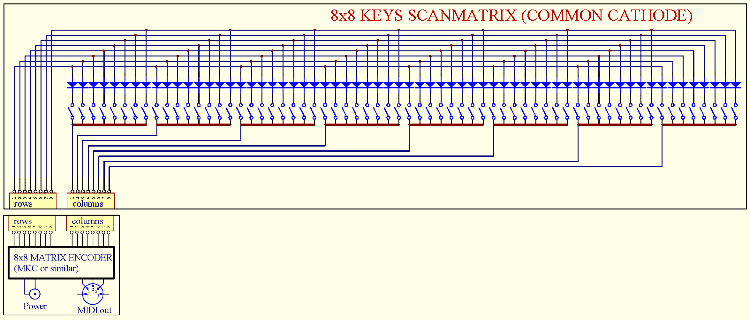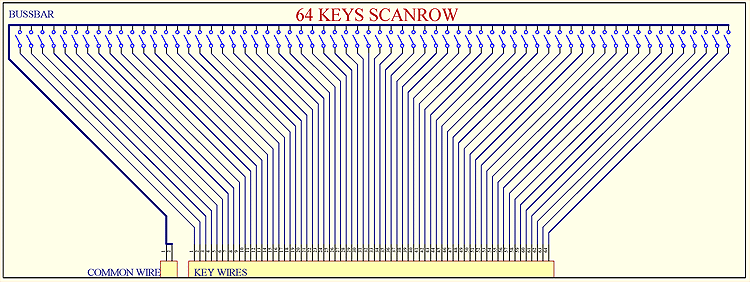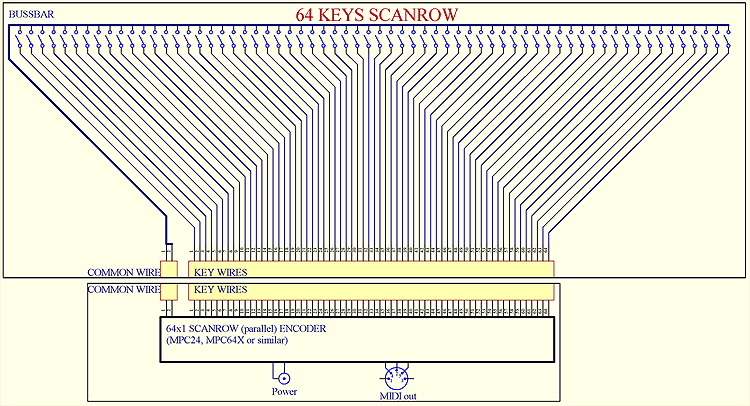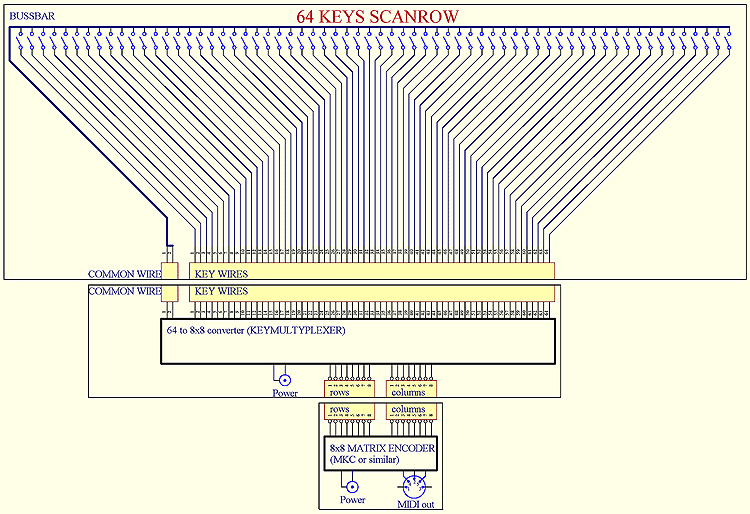FAQ
Here you can find answers to various often asked questions about MIDI. How does it work, regularly used terminology, study cases, MIDI Boutique customer experience.
MIDI Boutique
WHAT IS...
Below you can find the answers of the most common questions concerning our units. All definitions are given in context of MIDI encoders/decoders and may not be appliccable to other subjects of human knowledge.
- What is SCANMATRIX/SCANPOINT ?
SCANMATRIX is key contact arrangement allowing scanning of multiple key contacts using minimal wiring. The contacts in scanmatrix are also refered to as SCANPOINTS. Scanmatrix requires grouping of keys, most typically in groups of 8, with all contacts in group having common terminal. These groups are also called COLUMNS. The other terminal of contacts are wired as follows: all contacts placed at first position in the groups are wired together to ROW1, all contacts placed at second position are wired together, forming ROW2 etc. In most typical 8x8 scanmatrix, there are 8 rows and 8 columns. Note that it is absolutely necessary to put single diode (1N4149 or similar) serially with each contact. The diode may reside both above and or below the contact (by schematic diagram). If diodes are missed, the scanner/encoder won't be able to tell the column of currently scanned key contact, and will output wrong MIDI messages.The schematic of 8x8 scanmatrix arrangement is shown below. Note that the whole set of 64 keys needs all in all 8+8=16 wires to connect to external world. Also note that there are two types of scanmatrices: common anode and common cathode. The difference between these types is in key indexing. Per example, Key#3 will reside on Row#, Col#3 in common cathode matrix, and the same Key#3 will reside on Row#3, Col#1 in common anode matrix. Therefore, the encoder should be designed (set) for the right type of scanmatrix, to be able to scan/interpret keys in right order.
This is system where you have wired together an matrix-organized key contact system and scanmatrix encoder unit. The connection between these parts is more than simple. They are connected via 8+8 = 16 wires, usually 2 ribbon cables, each of 8 wires. The schematic below illustrates a system where an commn-cathode scsanmatix takes place.
- What is SCANROW ?
In contast to Scanmatrix, SCANROW is key contact organinzation where all key contacts have one common terminal. The wire going thru upper (by schematic) terminals is also called BUSSBAR. The other terminal of each key contact is wired separately to the external worls. Therefore1+64 wires are needed for connecting 64 key contacts to external world. Note that diodes are not necessary in this type of organization.
System where you have wired together an scanrow-organized key contact system to scanrow (also called parallel) scanner-encoder unit. The connection between these parts requires many wires, which may be problem in big systems.
- SCANMATRIX pro's:
- minimal wiring for external connections
- cheap and small-sized encoders
- SCANMATRIX con's:
- requires diode per each contact
- requires cutting existing bussbar into pieces
- SCANROW pro's:
- easy implemented in existing old keyboard instruments where bussbar is widely used
- does not require additional elements like diodes
- SCANROW con's:
- needs too many wires (keys + 1) for connecting to external system
- parallel encoders that may be used for scanning such keyboards are more expensive and big in size
- in case a cheap matrix encoder is available, it cannot be used directly with SCANROW. Additional key multiplexor unit is required for this.
- If existing keyboard system, of scanrow (bussbar) organization has to be turned into MIDI instrument without re-arranging its organization, and scanmatrix encoder is used, an additional unit called KEYMULTIPLEXOR is required, inserted between the keyboard scanrow and scanmatrix encoder. Since the keyrow has many output wires, and matrix encoder has few inputs, the KEYMULTIPLEXOR transforms the parallel data coming from keyboard to matryx-data, required by the encoder. Since the most of encoders we offer are of matrix type, the KEYMULTIPLEXOR could be an easy way to fit our MIDI encoders to existing keyboards without re-arranging them, and at the same time using minimized number of wires between the keyboard and encoder. KEYMULTIPLEXOR usually is close to the keyboard contacts, even wired directly to them. The rest of connections are done using ribbon cables, each consisting of 8 wires.
- SAM switches are normal toggle switches that are motorized by means of two small solenoids. SAMs are widely used in organs. They can be operated manually, by the organ player, but can also be controlled by organ's electronic on recalling memorized presets of stops. Below are pictures of most typical SAM switch, manufactured by Syndyne corp.
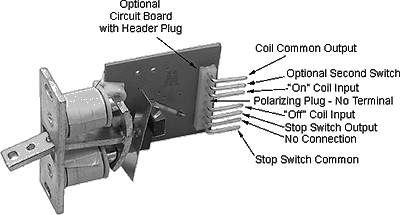
- What is Reed contact ?
Reed contact is an hermetically sealed contact actuated by magnetic field. It is very robust against dust and humidity which are serious problem for any contact system. Reed contact are widely used in keyboards, especially in pedalboard where there is a room enough for actuating magnets. The actuating magnet can be of various shape and size. The typical Reed contact used in keyboards/pedalboards is 20 x 3 mm in size (terminals not included). Both Reed contact and actuating magnet are shown on picture below. The size of magnet shown is 20 x 10 x 5 mm.

The difference between active and passive keying is:
With passive (GND) keying the busbar is supposed to be connected to common/GND/0V line of keyer.
The keying voltage of +5V is supplied by keyer inputs and they sense High-Low
transition of input upon make and Low-High transition upon break.
With active (for example +12V) the busbar is connected to +12V keying voltage source inside console.
The GND line of keyer must be connected to GND line of console (they must have common ground).
The +12V keying voltage is applied to keyer inputs by busbar via key contacts.
The keyer inputs are internaly pulled down to GND (0V).
They sense Low-High transition upon make and High-Low transition upon break.
MIDI Boutique
WHAT IS...
Below you can find the answers of the most common questions concerning our units. All definitions are given in context of MIDI encoders/decoders and may not be appliccable to other subjects of human knowledge.
- What is SCANMATRIX/SCANPOINT ?
SCANMATRIX is key contact arrangement allowing scanning of multiple key contacts using minimal wiring. The contacts in scanmatrix are also refered to as SCANPOINTS. Scanmatrix requires grouping of keys, most typically in groups of 8, with all contacts in group having common terminal. These groups are also called COLUMNS. The other terminal of contacts are wired as follows: all contacts placed at first position in the groups are wired together to ROW1, all contacts placed at second position are wired together, forming ROW2 etc. In most typical 8x8 scanmatrix, there are 8 rows and 8 columns. Note that it is absolutely necessary to put single diode (1N4149 or similar) serially with each contact. The diode may reside both above and or below the contact (by schematic diagram). If diodes are missed, the scanner/encoder won't be able to tell the column of currently scanned key contact, and will output wrong MIDI messages.The schematic of 8x8 scanmatrix arrangement is shown below. Note that the whole set of 64 keys needs all in all 8+8=16 wires to connect to external world. Also note that there are two types of scanmatrices: common anode and common cathode. The difference between these types is in key indexing. Per example, Key#3 will reside on Row#, Col#3 in common cathode matrix, and the same Key#3 will reside on Row#3, Col#1 in common anode matrix. Therefore, the encoder should be designed (set) for the right type of scanmatrix, to be able to scan/interpret keys in right order.
This is system where you have wired together an matrix-organized key contact system and scanmatrix encoder unit. The connection between these parts is more than simple. They are connected via 8+8 = 16 wires, usually 2 ribbon cables, each of 8 wires. The schematic below illustrates a system where an commn-cathode scsanmatix takes place.
- What is SCANROW ?
In contast to Scanmatrix, SCANROW is key contact organinzation where all key contacts have one common terminal. The wire going thru upper (by schematic) terminals is also called BUSSBAR. The other terminal of each key contact is wired separately to the external worls. Therefore1+64 wires are needed for connecting 64 key contacts to external world. Note that diodes are not necessary in this type of organization.
System where you have wired together an scanrow-organized key contact system to scanrow (also called parallel) scanner-encoder unit. The connection between these parts requires many wires, which may be problem in big systems.
- SCANMATRIX pro's:
- minimal wiring for external connections
- cheap and small-sized encoders
- SCANMATRIX con's:
- requires diode per each contact
- requires cutting existing bussbar into pieces
- SCANROW pro's:
- easy implemented in existing old keyboard instruments where bussbar is widely used
- does not require additional elements like diodes
- SCANROW con's:
- needs too many wires (keys + 1) for connecting to external system
- parallel encoders that may be used for scanning such keyboards are more expensive and big in size
- in case a cheap matrix encoder is available, it cannot be used directly with SCANROW. Additional key multiplexor unit is required for this.
- If existing keyboard system, of scanrow (bussbar) organization has to be turned into MIDI instrument without re-arranging its organization, and scanmatrix encoder is used, an additional unit called KEYMULTIPLEXOR is required, inserted between the keyboard scanrow and scanmatrix encoder. Since the keyrow has many output wires, and matrix encoder has few inputs, the KEYMULTIPLEXOR transforms the parallel data coming from keyboard to matryx-data, required by the encoder. Since the most of encoders we offer are of matrix type, the KEYMULTIPLEXOR could be an easy way to fit our MIDI encoders to existing keyboards without re-arranging them, and at the same time using minimized number of wires between the keyboard and encoder. KEYMULTIPLEXOR usually is close to the keyboard contacts, even wired directly to them. The rest of connections are done using ribbon cables, each consisting of 8 wires.
- SAM switches are normal toggle switches that are motorized by means of two small solenoids. SAMs are widely used in organs. They can be operated manually, by the organ player, but can also be controlled by organ's electronic on recalling memorized presets of stops. Below are pictures of most typical SAM switch, manufactured by Syndyne corp.

The difference between active and passive keying is:
With passive (GND) keying the busbar is supposed to be connected to common/GND/0V line of keyer.
The keying voltage of +5V is supplied by keyer inputs and they sense High-Low
transition of input upon make and Low-High transition upon break.
With active (for example +12V) the busbar is connected to +12V keying voltage source inside console.
The GND line of keyer must be connected to GND line of console (they must have common ground).
The +12V keying voltage is applied to keyer inputs by busbar via key contacts.
The keyer inputs are internaly pulled down to GND (0V).
They sense Low-High transition upon make and High-Low transition upon break.
There are no products to list in this category.


